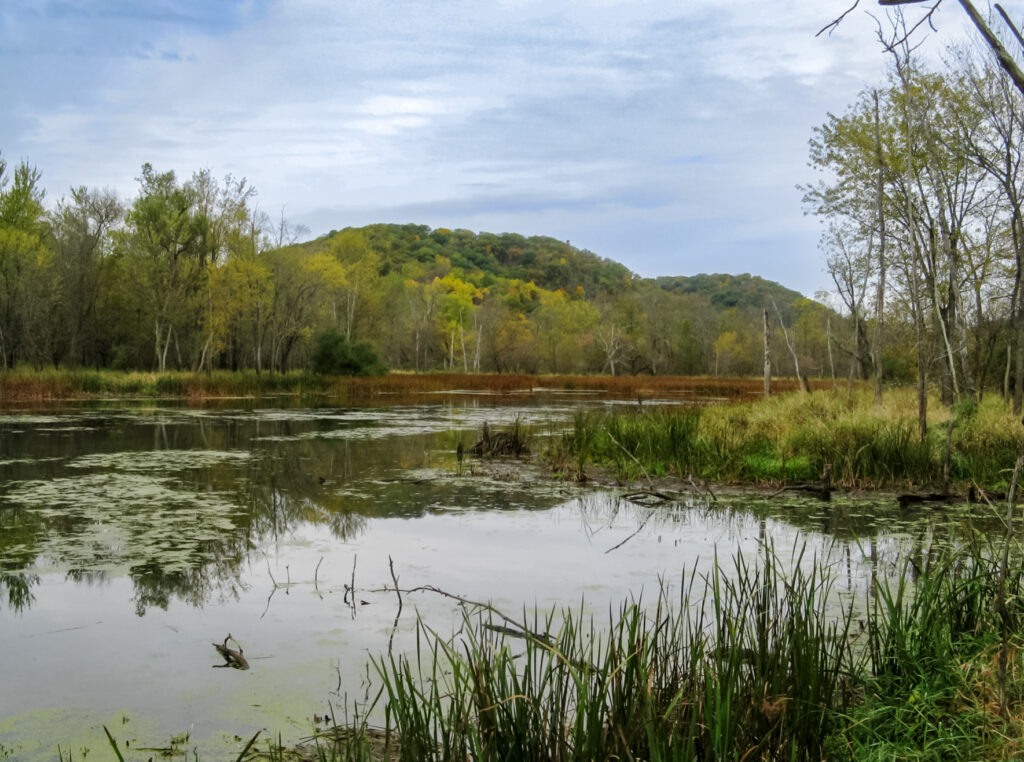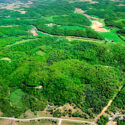When most people think of the Midwest, flat, dry land comes to mind. Little do they know that this region is home to one of the most complex ecological landmarks in the United States: The Driftless Area. Not only is this area a rarity in landscape, but it’s also home to many endangered species that have adapted to live there.
The Driftless Area is unique for a very specific reason – it was spared from the effects of the last ice age. Most of the Midwest was flattened gradually as glaciers moved across it, evening out hills and filling valleys with their dirt. But the Driftless Area, which spans over 24,000 miles in southeast Minnesota, northeast Iowa, southwest Wisconsin and northwest Illinois, has no glacial fill from the ice age. No glaciers ‘drifted’ across it, giving it the name “Driftless.” As a result, it has a distinct topography that is characterized by steep valleys and rolling hills.
“Because the glaciers missed us, we have all of this topography,” said Erin Cubbon, naturalist for the Allamakee County Conservation Board. “In areas where the glaciers cover the region, they leave behind what’s called glacial drift or glacial pill. It’s essentially the rock that sediment gets left behind when the glaciers melt away. So since we didn’t have glaciers here, we don’t see any of that glacial drift.”
A Home to Unique Species and Habitats
The Driftless Area is not just a geological anomaly — it’s also home to a wide variety of wildlife and habitats that are of great ecological significance. Because of its unique topography, these animals have evolved to live within those hills and valleys, and rely on it for their way of life.
“There are large tracts of contiguous forests that are important for migratory songbirds and a mosaic of upland grassland fields that are utilized by grassland birds that have been on a steep decline over the past decades,” said Chris Kirkpatrick, conservation specialist for the Mississippi Valley Conservancy.

One of the most unique features of the Driftless Area are algific talus slopes — areas where cool air seeps down the hillsides due to limestone caves breaking the surface. This creates microclimates that support the growth of plant and animal species that aren’t found anywhere else on the planet.
These species are the Iowa Pleistocene snail and the northern monkshood plant. Both inhabit these slopes – and only these slopes. They don’t live anywhere else in the world and are both classified as an endangered species by the Environmental Protection Agency (EPA). Both of these species are on the verge of extinction because of natural – but mostly human – threats.
What’s the Big Deal?
It’s been seen on television time and time again. A species becomes endangered, and their value skyrockets on the black market. It doesn’t look like the stereotypical group of scary men wearing all black, negotiating around a table. Poaching takes many different forms, from sellers posed as hikers to everyday citizens wanting an exotic plant for their house.
It’s natural to wonder, “Is saving a small little snail or plant that important?”
Yes. It’s important to remember that while many people are familiar with larger, well-known endangered species, there are many smaller, lesser-known species that are just as important to the environment. Ecosystems rely on the smallest organisms to thrive, and the extinction of one organism could cause the whole ecosystem to malfunction or even collapse.
“Not only that, we have these trout streams. We have the Mississippi River. We have wetlands that provide habitat to a lot of migrating bird species,” Buddon said. “It’s essentially a wealth of natural resources for a lot of creatures that either live here all the time or that migrate through.”
Unfortunately, the Driftless Area and its inhabitants are facing a number of threats. Poaching continues to be a major problem, particularly when it comes to wild orchids. Other endangered species in the area include the Hine’s emerald dragonfly, the eastern massasauga rattlesnake and the Indiana bat. These species, along with many others, are in danger of disappearing forever if action isn’t taken to protect them.
Ecosystems need smaller organisms like the orchids and dragonflies to support and feed the larger organisms. If these species cease to exist, so will the species that they support, causing grave changes in the environment. In the case of the Iowa Pleistocene snail and the northern monkshood plant, the fragile ecosystems that these two live in will die if the species are not saved.
What Can Be Done
So what can be done to help protect the Driftless Area and its endangered species? According to Kirkpatrick, there are many things.
“People can support their local land trust, get involved with work parties to help care for these landscapes, attend field trips to learn more about the rare and unique wildlife and habitats and create more native habitats for the rare wildlife in their backyard or property,” Kirkpatrick said.
Cubbon emphasizes that simply leaving these creatures alone and not engaging in activities like poaching can make a big difference. When people visit the Driftless area, some see a pretty flower and take it home, without knowing the impact that it has on the ecosystem and species. While this is a seemingly harmless act to the visitor, it can have a huge impact on the wildlife in the area.
“If people don’t know about things, if people don’t care about them, then there really is no hope,” Cubbon said. “So awareness is huge.”

